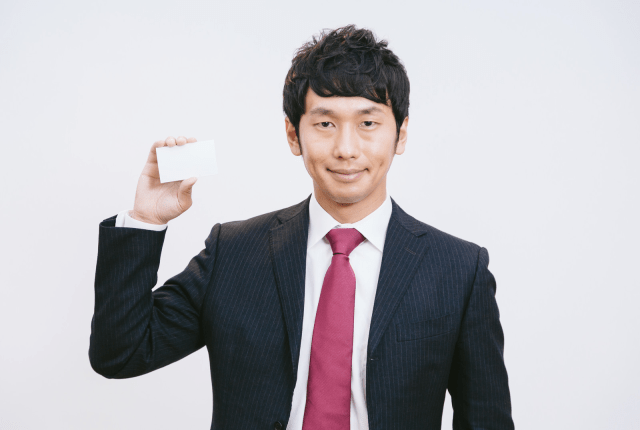
If you want to look suave and polite, these are the four steps.
Business cards are a big deal in Japan. You’ll see them exchanged at every meeting between professionals, and they’re to be treated with the utmost respect, as though they’re a thin, paper extension of their owners themselves.
Because of their importance, there’s also a thorough subsection of Japanese etiquette devoted to how exactly you should go about handing over your business card and receiving someone else’s. Japanese Twitter user @nursemens4321 recently heard his parents grumbling about how young employees at their offices don’t know all the finer points. So he decided to brush up on business card exchange manners, and was so surprised at how much he had to learn that he diagrammed what he found in illustrated form.
親が「若い社員が名刺の交換方法も知らない」つってて
— 看護メン (@nursemens4321) November 10, 2018
紙の交換に方法もクソもないだろと思ってたら本当に決まり事があるっぽい
茶の湯かよ pic.twitter.com/nTxdaXGdhJ
First, you’ll want to get out one business card for each member of the meeting, and place them in a tidy stack atop your business card holder (keeping business cards loose in your pocket is considered immature and, in the case of other’s people’s cards that you’ve received, disrespectful). Hold the stack steady with your thumbs at the corners closest to yourself, with the card’s text oriented so that it’s right-side-up from the other person’s perspective.
You should hold the stack at roughly chest level. However, as a sign of polite deference, it’s best to hold your stack slightly below your counterpart’s, as Japanese etiquette dictates that things of higher importance should occupy a higher physical position. This sometimes results in both parties going back and forth lowering their stacks, in an effort to convey their humility, but in any case, starting at around chest-height is considered the best form.
▼ Meanwhile, here’s a visual example of what not to do.
Then it’s time to actually exchange cards. Using your right thumb, give the top card a slight slide forward, to make it easier for your counterpart to grasp it. Meanwhile, with your left hand, accept the other person’s card.
Place your counterpart’s card atop your case, and as soon as you’ve completed the exchange, quickly make sure you’ve got the card secured with both hands. Holding someone else’s card with just one hand conveys the idea that the object is light, and by extension of little importance. Be careful, though, not to cover any of the card’s text, photos, logos, or other graphics with your thumbs, however. After all, doing so means that you can’t see the hidden sections, and therefore not interested in them.
Once you’ve got the card in place, take a few moments to earnestly study it and commit its information to memory. Stuffing it into the interior of your case too soon, once again, implies that you haven’t really taken the time to carefully read it, because you don’t really care that much about the person or their organization.
Now it’s worth noting, just as @nursemens4321’s parents did, that not everyone in Japan is well-versed in who follows all of the steps to the letter. @nursemens4321 himself, for example, was unaware of some of the points, and thus wouldn’t have been offended if someone skipped one or two, and holding just your card in both hands, as opposed to setting it atop your business card case, isn’t a huge faux pas. However, if you want to make a good impression and show your respect for Japanese culture and tradition to your business partner, the techniques outlined in @nursemens4321’s illustration are an excellent place to start.
Source: @nursemens4321 via Jin
Top image: Pakutaso
Insert images: Pakutaso
Follow Casey on Twitter, where his favorite part of Japanese business etiquette is how to split wooden chopsticks at a business lunch.


 Rules of tea, business cards, and bowing – 10 Japanese business manners young people are tired of
Rules of tea, business cards, and bowing – 10 Japanese business manners young people are tired of Tokyo shop selling ultra-rare Magic: The Gathering card for eight-figure price
Tokyo shop selling ultra-rare Magic: The Gathering card for eight-figure price A beginner’s guide on how to keep your favorite trading cards in mint condition
A beginner’s guide on how to keep your favorite trading cards in mint condition Japan makes card game to help kids raise disaster prevention awareness
Japan makes card game to help kids raise disaster prevention awareness How to rob an idol singer otaku: Look up the birthday of his favorite idol
How to rob an idol singer otaku: Look up the birthday of his favorite idol Foreigner’s request for help in Tokyo makes us sad for the state of society
Foreigner’s request for help in Tokyo makes us sad for the state of society Japanese city loses residents’ personal data, which was on paper being transported on a windy day
Japanese city loses residents’ personal data, which was on paper being transported on a windy day Ghibli Park now selling “Grilled Frogs” from food cart in Valley of Witches
Ghibli Park now selling “Grilled Frogs” from food cart in Valley of Witches Osaka governor suggests lowering voting age to 0 to curb population decline
Osaka governor suggests lowering voting age to 0 to curb population decline Sandwiches fit for a sumo served up in Osaka【Taste Test】
Sandwiches fit for a sumo served up in Osaka【Taste Test】 Japan’s cooling body wipe sheets want to help you beat the heat, but which work and which don’t?
Japan’s cooling body wipe sheets want to help you beat the heat, but which work and which don’t? Harajuku Station’s beautiful old wooden building is set to return, with a new complex around it
Harajuku Station’s beautiful old wooden building is set to return, with a new complex around it Historical figures get manga makeovers from artists of Spy x Family, My Hero Academia and more
Historical figures get manga makeovers from artists of Spy x Family, My Hero Academia and more Beautiful Red and Blue Star luxury trains set to be Japan’s new Hokkaido travel stars
Beautiful Red and Blue Star luxury trains set to be Japan’s new Hokkaido travel stars Smash Bros. director Sakurai stabs Kirby in the face, has delicious justification for it
Smash Bros. director Sakurai stabs Kirby in the face, has delicious justification for it McDonald’s new Happy Meals offer up cute and practical Sanrio lifestyle goods
McDonald’s new Happy Meals offer up cute and practical Sanrio lifestyle goods Japanese ramen restaurants under pressure from new yen banknotes
Japanese ramen restaurants under pressure from new yen banknotes French Fries Bread in Tokyo’s Shibuya becomes a hit on social media
French Fries Bread in Tokyo’s Shibuya becomes a hit on social media Studio Ghibli releases new action figures featuring Nausicaä of the Valley of the Wind characters
Studio Ghibli releases new action figures featuring Nausicaä of the Valley of the Wind characters New private rooms on Tokaido Shinkansen change the way we travel from Tokyo to Kyoto
New private rooms on Tokaido Shinkansen change the way we travel from Tokyo to Kyoto Red light district sushi restaurant in Tokyo shows us just how wrong we were about it
Red light district sushi restaurant in Tokyo shows us just how wrong we were about it Tokyo Tsukiji fish market site to be redeveloped with 50,000-seat stadium, hotel, shopping center
Tokyo Tsukiji fish market site to be redeveloped with 50,000-seat stadium, hotel, shopping center All-you-can-drink Starbucks and amazing views part of Tokyo’s new 170 meter-high sky lounge
All-you-can-drink Starbucks and amazing views part of Tokyo’s new 170 meter-high sky lounge Beautiful Ghibli sealing wax kits let you create accessories and elegant letter decorations【Pics】
Beautiful Ghibli sealing wax kits let you create accessories and elegant letter decorations【Pics】 Studio Ghibli releases Kiki’s Delivery Service chocolate cake pouches in Japan
Studio Ghibli releases Kiki’s Delivery Service chocolate cake pouches in Japan New definition of “Japanese whiskey” goes into effect to prevent fakes from fooling overseas buyers
New definition of “Japanese whiskey” goes into effect to prevent fakes from fooling overseas buyers Our Japanese reporter visits Costco in the U.S., finds super American and very Japanese things
Our Japanese reporter visits Costco in the U.S., finds super American and very Japanese things Studio Ghibli unveils Mother’s Day gift set that captures the love in My Neighbour Totoro
Studio Ghibli unveils Mother’s Day gift set that captures the love in My Neighbour Totoro More foreign tourists than ever before in history visited Japan last month
More foreign tourists than ever before in history visited Japan last month New Pokémon cakes let you eat your way through Pikachu and all the Eevee evolutions
New Pokémon cakes let you eat your way through Pikachu and all the Eevee evolutions Sales of Japan’s most convenient train ticket/shopping payment cards suspended indefinitely
Sales of Japan’s most convenient train ticket/shopping payment cards suspended indefinitely Sold-out Studio Ghibli desktop humidifiers are back so Totoro can help you through the dry season
Sold-out Studio Ghibli desktop humidifiers are back so Totoro can help you through the dry season Japanese government to make first change to romanization spelling rules since the 1950s
Japanese government to make first change to romanization spelling rules since the 1950s Ghibli founders Toshio Suzuki and Hayao Miyazaki contribute to Japanese whisky Totoro label design
Ghibli founders Toshio Suzuki and Hayao Miyazaki contribute to Japanese whisky Totoro label design Doraemon found buried at sea as scene from 1993 anime becomes real life【Photos】
Doraemon found buried at sea as scene from 1993 anime becomes real life【Photos】 Tokyo’s most famous Starbucks is closed
Tokyo’s most famous Starbucks is closed One Piece characters’ nationalities revealed, but fans have mixed opinions
One Piece characters’ nationalities revealed, but fans have mixed opinions We asked a Uniqlo employee what four things we should buy and their suggestions didn’t disappoint
We asked a Uniqlo employee what four things we should buy and their suggestions didn’t disappoint Princesses, fruits, and blacksmiths: Study reveals the 30 most unusual family names in Japan
Princesses, fruits, and blacksmiths: Study reveals the 30 most unusual family names in Japan Japanese TV network makes multiple apologies for reporter chewing gum on air【Video】
Japanese TV network makes multiple apologies for reporter chewing gum on air【Video】 Free Final Fantasy and Dragon Quest Valentine’s cards available online from Square Enix【Photos】
Free Final Fantasy and Dragon Quest Valentine’s cards available online from Square Enix【Photos】 Travel tip: McDonald’s Japan will finally let you pay for your food with a credit card
Travel tip: McDonald’s Japan will finally let you pay for your food with a credit card Anime about nasty contract surprises gets real-life credit card with nasty contract surprises
Anime about nasty contract surprises gets real-life credit card with nasty contract surprises New Welcome to Kanto Pasmo IC Card is the most kawaii way to ride trains on a trip to Japan
New Welcome to Kanto Pasmo IC Card is the most kawaii way to ride trains on a trip to Japan One bizarre Japanese trading card gets a literal strength bonus from this weekend’s typhoon
One bizarre Japanese trading card gets a literal strength bonus from this weekend’s typhoon Japanese police face criticism for improper handling of stolen Pokémon and Yu-Gi-Oh cards【Video】
Japanese police face criticism for improper handling of stolen Pokémon and Yu-Gi-Oh cards【Video】 Japan Airlines adds a dash of magic to promote its new credit card【Video】
Japan Airlines adds a dash of magic to promote its new credit card【Video】 Yep, that’s illegal in Japan – Yakuza boss arrested for making supermarket point card
Yep, that’s illegal in Japan – Yakuza boss arrested for making supermarket point card Hyogo man arrested for stealing over 1,000 New Year greeting cards to “distract from loneliness”
Hyogo man arrested for stealing over 1,000 New Year greeting cards to “distract from loneliness” Things go from scary to sweet when Japanese traveler meets tattooed man on bus overseas【Manga】
Things go from scary to sweet when Japanese traveler meets tattooed man on bus overseas【Manga】 Otaku crime: Kyoto police arrest man for selling counterfeit ultra-rare Yu-Gi-Oh! card
Otaku crime: Kyoto police arrest man for selling counterfeit ultra-rare Yu-Gi-Oh! card Pikachu, other Pokémon recreate classic painting The Scream, have us squealing at their cuteness
Pikachu, other Pokémon recreate classic painting The Scream, have us squealing at their cuteness Japanese bar hostess’ secret memo reveals how she really sees her customers
Japanese bar hostess’ secret memo reveals how she really sees her customers Pokémon Wedding Plan being offered in Japan, complete with beautiful Pikachu wedding cake
Pokémon Wedding Plan being offered in Japan, complete with beautiful Pikachu wedding cake Yu-Gi-Oh! collector parts with ultra-rare cards worth more than $5,000 each, for his daughter
Yu-Gi-Oh! collector parts with ultra-rare cards worth more than $5,000 each, for his daughter
Leave a Reply